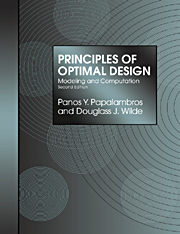Preface to the Second Edition
Summary
A dozen years have passed since this book was first published, and computers are becoming ever more powerful, design engineers are tackling ever more complex systems, and the term “optimization” is routinely used to denote a desire for ever increasing speed and quality of the design process. This book was born out of our own desire to put the concept of “optimal design” on a firm, rigorous foundation and to demonstrate the intimate relationship between the mathematical model that describes a design and the solution methods that optimize it.
A basic premise of the first edition was that a good model can make optimization almost trivial, whereas a bad one can make correct optimization difficult or impossible. This is even more true today. New software tools for computer aided engineering (CAE) provide capabilities for intricate analysis of many difficult performance aspects of a system. These analysis models, often referred to also as simulations, can be coupled with numerical optimization software to generate better designs iteratively. Both the CAE and the optimization software tools have dramatically increased in sophistication, and design engineers are called to design highly complex problems, with few, if any, hardware prototypes.
The success of such attempts depends strongly on how well the design problem has been formulated for an optimization study, and on how familiar the designer is with the workings and pitfalls of iterative optimization techniques.
- Type
- Chapter
- Information
- Principles of Optimal DesignModeling and Computation, pp. xiii - xviPublisher: Cambridge University PressPrint publication year: 2000



